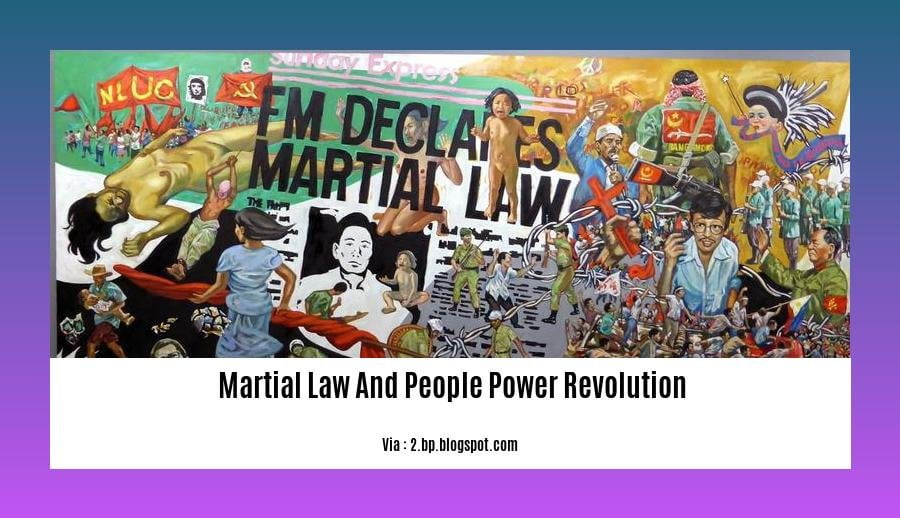In [The Martial Law and People Power Revolution: A Historian’s Perspective], we delve into the intricacies of a defining era in Philippine history, exploring the imposition of Martial Law and the subsequent People Power Revolution. Through the lens of meticulous research and firsthand accounts, this article unveils the complexities of authoritarian rule, the indomitable spirit of a nation, and the transformative power of collective action.
Key Takeaways:
- The People Power Movement emerged before martial law as activists protested human rights abuses.
- Marcos imposed martial law in 1972, creating a “New Society” under authoritarian rule.
- Martial law resulted in crony capitalism, economic crisis, and social conflicts.
- From 1986-1987, popular protests along EDSA led to Marcos’ overthrow and the People Power Revolution.
- The revolution became a nonviolent model for regime change, inspiring uprisings in other countries.
Martial Law and People Power Revolution

Martial Law and People Power Revolution are significant moments that shaped Philippine history.
The Prelude
Public outcry against the Marcos administration, fueled by human rights abuses, spurred the People Power Movement into action. The movement sought to expose these grave injustices, sowing the seeds of dissent before Martial Law was imposed.
Marcos’s Grip on Power: The Declaration of Martial Law
On September 23, 1972, Ferdinand Marcos declared Martial Law, seizing absolute authority and establishing a so-called “New Society” under his authoritarian rule.
The Economic and Social Toll
The Martial Law regime fostered a system of crony capitalism, widening economic disparities. This, coupled with censorship and human rights violations, ignited social unrest.
The Triumph of the People: The People Power Revolution
A turning point came when the assassination of opposition leader Benigno Aquino Jr. sparked massive street protests. From February 22-25, 1986, protestors flocked to EDSA in a display of people power. This peaceful uprising, supported by military defectors, culminated in the overthrow of Marcos and the restoration of democracy.
A Legacy of Change
The People Power Revolution became a beacon of hope, inspiring nonviolent regime changes worldwide. Its message of unity and democratic ideals continues to resonate in the Philippines today.
To learn about the enthralling journey of the Philippines through time, delve into the History of the Philippines. Discover the profound impact of the Spanish colonization and witness the valiant struggle for independence in the Philippine Revolution of 1896.
People Power: The Rise of Non-Violent Resistance

The People Power movement in the Philippines emerged during the 1970s and ’80s, culminating in the peaceful “People Power Revolution” that toppled the authoritarian Marcos regime in 1986.
Understanding the Context
Before Marcos declared martial law in 1972, years of public frustration simmered. The People Power movement galvanized around human rights violations, economic inequality, and the erosion of democratic freedoms.
The Role of Civil Society
Civil society organizations played a crucial role in documenting the atrocities of martial law, raising awareness both domestically and internationally.
The Catalyst: Benigno Aquino Jr.’s Assassination
The 1983 assassination of opposition leader Benigno Aquino Jr. ignited massive protests, triggering a series of events that led to the People Power revolution.
The Power of Non-Violence
Central to the People Power movement was its commitment to non-violence. Instead of armed resistance, Filipinos employed peaceful demonstrations, civil disobedience, and mass gatherings.
Key Features of People Power
- Peaceful Assemblies: Crowds gathered on the streets, often led by the clergy and opposition leaders, demanding Marcos’s resignation.
- Economic Boycotts: People organized consumer boycotts against businesses associated with the Marcos regime.
- Civil Disobedience: Citizens refused to cooperate with government orders, such as closing businesses during designated hours.
- Media Engagement: The Catholic Church and independent media played a vital role in disseminating information and galvanizing public support.
- Military Defections: In the final days of the revolution, key military commanders switched sides, crippling Marcos’s authority.
Key Takeaways:
- The People Power movement was a collective effort driven by a desire for freedom and democracy.
- Non-violence was a defining characteristic, proving its efficacy in challenging authoritarianism.
- Civil society organizations played a pivotal role in mobilizing people and documenting human rights abuses.
- The assassination of Benigno Aquino Jr. was a catalyst for the uprising.
- People Power became a global symbol of non-violent resistance, inspiring similar movements worldwide.
Relevant URL Sources:
- Non-violent Direct Action Case Study: People Power in the Philippines
- ‘People Power’ as Immanent Collectivity: Revolution in the Philippines, 1983-1986
People Power Revolution: The Triumph of Collective Action
The People Power Revolution of 1986 stands as a testament to the unwavering spirit of the Filipino people. It was a nonviolent uprising that toppled a 21-year dictatorship, proving that collective action and determination could overcome even the most oppressive regimes.
The Spark
The revolution was ignited by the assassination of Benigno Aquino Jr., a charismatic opposition leader. This act of violence ignited widespread outrage and fueled a growing protest movement known as the People Power Movement.
The Uprising
On February 22, 1986, thousands of Filipinos gathered on Epifanio de los Santos Avenue (EDSA), a major thoroughfare in Manila. They formed a human barricade, preventing government forces from dispersing them. In a remarkable display of unity, the military, led by Defense Minister Juan Ponce Enrile and Deputy Chief of Staff Fidel Ramos, defected and joined the protesters.
The Victory
For four days, the crowds held their ground, demanding the ouster of Ferdinand Marcos. On February 25, Marcos fled the country, and Corazon Aquino, Aquino Jr.’s widow, was sworn in as the new president. The People Power Revolution had triumphed, marking a watershed moment in Philippine history.
Key Takeaways
- Collective action can overcome even the most daunting challenges.
- Nonviolence can be a powerful force for change.
- The People Power Revolution continues to inspire movements for democracy around the world.
Most Relevant URL Sources
A Historicised (Re)Assessment of EDSA ‘People Power’ (1986)
The EDSA People Power Revolution of 1986 | The Manila Times
Legacy of the People Power Revolution: Lessons and Impact
As a historian, I’ve followed the People Power Revolution with great interest. Its legacy continues to inspire me today.
Lessons Learned
The People Power Revolution is a remarkable example of nonviolent resistance. When facing oppression, it taught us that people can unite and stand up for their rights.
Impacts
The revolution had a profound impact not just in the Philippines but around the world. It showed that authoritarian regimes can be overthrown without violence. The revolution also led to a new era of democracy, sparking hope for other nations struggling under oppressive rule.
Key Takeaways:
- Nonviolent resistance can overcome authoritarianism.
- People’s unity and determination can bring about change.
- The People Power Revolution serves as an inspiration for democratic movements worldwide.
Relevant URL Sources
– Origins: The People Power Revolution, Philippines 1986
– Martial Law Museum: EDSA People Power Revolution: Then, now, and what…
FAQ
Q1: What sparked the People Power Revolution?
Q2: What were the key events that led to the declaration of Martial Law?
Q3: What were some of the major economic and social impacts of Martial Law?
Q4: How did the People Power Revolution challenge the authoritarian rule of Ferdinand Marcos?
Q5: What is the legacy of the People Power Revolution and how has it influenced other democratic movements worldwide?
- Unveiling the Enigma: Mansoureh Khojasteh Bagherzadeh’s Public Appearances & Private Life in Iran - July 18, 2025
- Unveiling the Mystery: Mansoureh Khojasteh Bagherzadeh’s Husband: A Rare Glimpse into a Private Life - July 18, 2025
- Unveiling Masoud Khamenei’s Mother: Power, Influence, and Iran’s Future - July 18, 2025
















